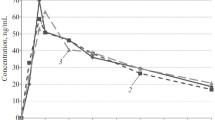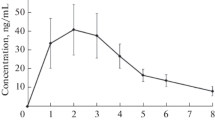Summary
Verapamil has been demonstrated to inhibit the elimination of digoxin and to increase its steady state plasma level by 60–80%. Animal studies suggest that verapamil abolishes the intropic action of other drugs such as ouabain and dopamine. The clinical consequences of this drug interaction were investigated by examining the inotropic activity of single doses of digoxin (assessed from systolic time intervals), with and without coadministration of verapamil. Verapamil decreased total-body clearance of digoxin from 4.68±0.41 to 3.29±0.26 ml/min/kg (p<0.001) and increased the plasma half-life of the drug from 33.50±2.38 to 41.31±2.27 h (p<0.01). Verapamil had no influence on the base-line values of the systolic time intervals. Both in the absence and presence of verapamil, digoxin caused significant shortening of the total electromechanical systole and the left ventricular ejection time. However, compared to control conditions, the decay of these changes was slower in the presence of verapamil, in parallel with the prolongation of the plasma half-life of digoxin. A linear relationship was established between reductions in the systolic time intervals and the computer-derived concentration of digoxin in the deep compartment. These regression lines, which represent the concentration-effect relationships of the inotropism of digoxin, were not affected by verapamil. Thus, verapamil per se had no measurable effect either on base-line contractile function of the heart or on digoxin-induced inotropism. The elevated plasma digoxin concentration induced by verapamil appears cardioactive in terms of inotropism.
Similar content being viewed by others
References
Pedersen KE, Dorph-Pedersen A, Hvidt S, Klitgaard NA, Nielsen-Kudsk F (1981) Digoxin-verapamil interaction. Clin Pharmacol Ther 30: 311–316
Klein HO, Lang R, Weiss E, Segni ED, Libhaber C, Guerrero J, Kaplinsky E (1982) The influence of verapamil on serum digoxin concentration. Circulation 65: 998–1003
Belz GG, Aust PE, Munkes R (1981) Digoxin plasma concentrations and nifedipine. Lancet 1: 844–845
Ball WJJr, Tse-Eng D, Bilezikian JP, Wallick E, Schwartz A, Butler VP (1979) Studies of a quinidine-digoxin interaction. Fed Proc 38: 1042
DoherteY JE, Straub KD, Murphey ML, De Soyza N, Bisset JK, Kane JJ (1980) Digoxin-quinidine interaction-changes in canine tissue concentration from steady state with quinidine. Am J Cardiol 45: 1196–1200
Straub KD, Kane JJ, Bisset JK (1978) Alteration of digitalis binding by quinidine: A mechanism of digitalis-quinidine interaction. Circulation [Suppl] 2: II
Hirsh PD, Weiner HJ, North RL (1980) Further insight into digoxin-quinidine interaction: Lack of correlation between serum digoxin concentration and inotropic state of the heart. Am J Cardiol 46: 863–868
Steiness E, Waldorff S, Hansen PB, Kjaergaard H, Buch J, Egeblad H (1980) Severe reduction of digoxin-induced inotropism during quinidine administration. Clin Pharmacol Ther 141: 791–795
Belz GG, Aust PE, Doering W, Heinz M, Schneider B (1982) Pharmacodynamics of a single dose of quinidine during chronic digoxin treatment. A randomized double blind placebo and sparteine-controlled crossover study. Eur J Clin Pharmacol 22: 111–117
Fleckenstein A (1977) Specific pharmacology of calcium in myocardium, cardiac pacemakers and vascular smooth muscle. Annu Rev Pharmacol Toxicol 17: 149–166
Fleckenstein A, Tritthart H, Döring H-J, Byron KY (1972) BAY a 1040 — ein hochaktiver Ca++-antagonistischer Inhibitor der elektro-mechanischen Koppelungsprozesse im Warmblüter-Myocard. Arzneimittelforsch 22: 22–23
Magnussen I, Nielsen-Kudsk F (1974) Effects of verapamil and propranolol on contractility, frequency, coronary flow and oxygen consumption in the isolated rabbit heart. Acta Pharmacol Toxicol 34: 141–151
Ferlintz J, Easthope JL, Aronow WS (1979) Effects of verapamil on myocardial performance in coronary disease. Circulation 59: 313–319
Ryden L, Satre H (1971) The haemodynamic effect of verapamil. Eur J Clin Pharmacol 3: 153–157
Singh BN, Roche AHG (1977) Effects of intravenous verapamil on hemodynamics in patients with heart disease. Am Heart J 94: 593–599
Goldman S, Olajos M, Morkin E (1982) Effects of verapamil on positive inotropic stimulation in the left atrium and ventricle of conscious dogs. J Pharmacol Exp Ther 222: 270–275
Wagner JG (1975) Fundamentals of clinical pharmacokinetics. Drug Intelligence Publications, Hamilton, Ill, USA
Gibaldi M, Perrier D (1975) Pharmacokinetics. Marcel Dekker, New York
Forrester W, Lewis RP, Weissler AM, Wilke TA (1974) The onset and magnitude of the contractile response to commonly used digitalis glycosides in normal subjects. Circulation 49: 517–521
Hoeschen RJ, Cuddy TE (1975) Dose-response relation between therapeutic levels of serum digoxin and systolic time intervals. Am J Cardiol 35: 469–472
Kelman AW, Summer DJ, Londsdale M, Lawrence JR, Whiting B (1980) Comparative pharmacokinetics and pharmacodynamics of cardiac glycosides. Br J Clin Pharmacol 10: 135–143
Weisler AM, Gamel WG, Grode HE, Cohen S, Schoenfeld CD (1964) The effect of digitalis on ventricular ejection in normal human subjects. Circulation 29: 721–729
Ochs HR, Grube E, Greenblatt DJ, Arendt R, Bodem G (1981) Pharmacokinetics and pharmacodynamics of intravenous digoxin and digitoxin. Klin Wochenschr 59: 889–897
Ochs HR, Otten H, Bodem G (1979) Digoxininduzierte Veränderungen des Belastungs-EKG in Relation zur Digoxinplasmakonzentration. Klin Wochenschr 57: 161–168
Nielsen-Kudsk F, Askholt J (1981) Myocardial pharmacokinetics and pharmacodynamics of nifedipine in the isolated rabbit heart. Acta Pharmacol Toxicol 48: 330–339
Mikkelsen E, Anderson KE, Lederballe Pedersen O (1979) Effect of digoxin on isolated human mesenteric vessels. Acta Pharmacol Toxicol 45: 25–31
Author information
Authors and Affiliations
Rights and permissions
About this article
Cite this article
Pedersen, K.E., Thayssen, P., Klitgaard, N.A. et al. Influence of verapamil on the inotropism and pharmacokinetics of digoxin. Eur J Clin Pharmacol 25, 199–206 (1983). https://doi.org/10.1007/BF00543791
Received:
Revised:
Accepted:
Issue Date:
DOI: https://doi.org/10.1007/BF00543791




